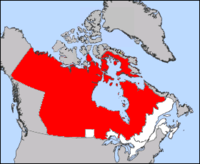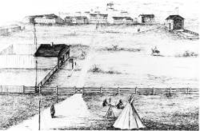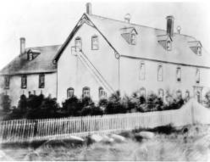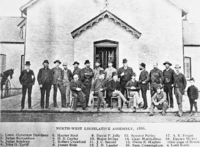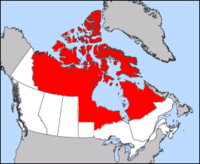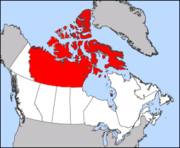History of Northwest Territories capital cities
2008/9 Schools Wikipedia Selection. Related subjects: North American History
| Northwest Territories capitals | ||
|---|---|---|
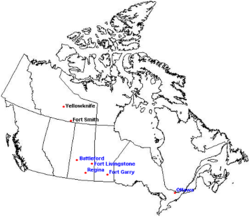 |
||
| City | Years | |
| Fort Garry | 1870–1876 | |
| Fort Livingstone | 1876–1877 | |
| Battleford | 1877–1883 | |
| Regina | 1883–1905 | |
| Ottawa | 1905–1967 | |
| Fort Smith | 1911–1967 | |
| Yellowknife | 1967–present | |
The history of Northwest Territories capital cities begins with the purchase of the Territories by Canada from the Hudson's Bay Company in 1869 and includes a varied and often difficult evolution. Northwest Territories is unique amongst the Canadian province or territory in that it has had seven capital cities in its history. The territory has changed the seat of government for numerous reasons, including civil conflict, development of infrastructure, and revised territorial boundaries.
The result of these changes has been a long and complex road to responsible government. Effectively providing services and representation for the population has been a particular challenge for the Territories' government, a task often complicated by the region's vast geographic area. A small number of communities in Northwest Territories have unsuccessfully tried to become the capital over the years. The territory has had the seat of government outside of its territorial boundaries twice in its history. The only other political division in Canada without a seat of government inside the territorial boundaries was the defunct District of Keewatin that existed from 1876 until 1905.
The term "capital" refers to cities that have served as home for the Legislative Assembly of Northwest Territories, the legislative branch of Northwest Territories government. In Canada, it is customary for provincial and territorial level government to have the civil service administer from the same city as the legislative branch and executive branch. The Northwest Territories, however, had an administrative capital and a legislative capital officially exist between 1911 and 1967. This is the only province or territory in Canadian history to have had such an arrangement.
In the early 1980s, the territory began a process that would see it divide itself. A new capital was needed for the brand new territory of Nunavut created out of the eastern half of the Northwest Territories as they existed from 1911 to 1999. Lessons were learned from the past changes in the seat of power, and a referendum was put to the territorial residents.
Fort Garry, Manitoba (1870–1876)
The Government of Canada purchased the North-Western Territory and Rupert's Land from the Hudson's Bay Company in 1868 under the terms of the Rupert's Land Act of 1868 for £300,000 British pounds. Both purchased territories were largely uninhabited, consisting mostly of uncharted wilderness. After the purchase, the Government decided to merge both of the properties into a single jurisdiction and appoint a single territorial government to run both. The purchase of the two territories added a sizable portion of the current Canadian landmass.
In 1869, Ontario Member of Parliament William McDougall was appointed as the first Lieutenant Governor of the Northwest Territories and sent to Fort Garry to establish formal governance for Canada. Before his party arrived at the settlement, a small group led by Louis Reil intercepted him near the Ontario border and forced him to turn back because they opposed the transfer to the Canadian government. The inhabitants of the Red River Valley began the Red River Rebellion delaying formal governance until their demands for provincial status were met.
The rebellion resulted in the creation of the Province of Manitoba (inclusive of Fort Garry) and a delay in establishing governance in the Territories. In 1870, the Northwest Territories and Manitoba formally entered the Canadian confederation. The two jurisdictions remained partially conjoined: under the Temporary Government Act, 1870. The Temporary North-West Council was appointed in 1872, mainly from members of the new Manitoba Legislative Assembly, with the Lieutenant Governor of Manitoba serving as the leader of the territorial government. The Governor and Council were mandated to govern the Territories through the Manitoba Act and did so from outside of the Northwest Territories. Fort Garry served as the first seat of government for both jurisdictions.
The temporary government sat for the first time in 1872 and was renewed by federal legislation each year until a permanent solution for governance was decided upon. The federal government renewed the Temporary Council for the last time in 1875 and chose a new location, within the boundaries of the Northwest Territories, to form a new government. Along with the new seat of power, a new council greatly reduced in size was appointed along with a new Lieutenant Governor to specifically lead the Territories without also governing Manitoba.
In the 1870s Fort Garry consisted of two distinct settlement. The first site was named Upper Fort Garry and secondary site named Lower Fort Garry 32 kilometres (20 mi) downstream on the Red River. After the territorial government moved, Fort Garry continued to be the seat of government for Manitoba, and for the now defunct District of Keewatin territory between 1876 to 1905. Fort Garry evolved to become modern-day Winnipeg, still the capital of Manitoba, with Lower Fort Garry being declared a national historical site.
Fort Livingstone, Northwest Territories (1876–1877)
The Northwest Territories Act, 1875 dissolved the Temporary North-West Council and appointed a permanent government to take effect on October 7, 1876. The new council governed from Fort Livingstone, an outpost constructed west of the Manitoba border, in modern-day Saskatchewan. Fort Livingstone served as a small frontier outpost and not as a bonnefied capital city. The location was chosen by the federal government as a temporary site to establish the new territorial government until the route of the railway was determined.
Fort Livingstone was founded in 1875 by the newly created North-West Mounted Police, the predecessor of the Royal Canadian Mounted Police, Canada's national police force. The Swan River North-West Mounted Police Barracks, inside Fort Livingstone, became the temporary assembly building for legislative council sessions as well as the office for the Lieutenant Governor.
The bulk of the police forces moved out to Fort Macleod in 1876 to crack down on the whiskey trade. A year later, Lieutenant Governor David Laird moved the seat of government to Battleford. The decision was based upon the original plans of constructing the Canadian Pacific Railway (CPR) through Battleford.
Fort Livingstone continued to serve as a small outpost until being totally destroyed by a prairie grass fire in 1884. The nearest modern settlement to the original Fort Livingstone site is Pelly, Saskatchewan, four kilometers to the south. The fort is sometimes referred to as Fort Pelly or Swan River. The Fort Livingstone site is marked with a plaque as was declared a Saskatchewan provincial heritage site and contains no resident population.
Battleford, Northwest Territories (1877–1883)
The Northwest Territories government moved to Battleford in 1877 on the order of the Lieutenant Governor. Battleford was supposed to be the permanent capital of the Territories. The town was chosen because it was expected to be linked with the Canadian Pacific Railway.
The government in Battleford would see significant milestones towards attaining responsible government for the Northwest Territories. For the first time, the territory had democratically elected members join the appointed members in the assembly. Elections in the territory became a reality after the passage of the Northwest Territories election ordinance 1880. The first election took place in 1881 after electoral districts were created by royal proclamations, issued the order of the Lieutenant Governor. Battleford hosted the first official royal visit in western Canada, when the Marquis of Lorne and Princess Louise Caroline Alberta toured the territories in 1881.
The first Northwest Territories legislature building, and residence for the Lieutenant Governor named "NWT Government House", was completed and used by the territorial government until 1883. After the government moved the building stood as a historical site until it was destroyed in a fire in 2003.
After consultation with Canadian Pacific Railway officials, Lieutenant Governor Edgar Dewdney made the decision to move the capital to Regina, also in present-day Saskatchewan, in June 1882. The decision to move the capital was controversial with the public because Edgar Dewdney owned real estate in Regina. He was accused of having conflicted interests between his private affairs and the needs of the government.
Regina, Northwest Territories (1883–1905)
After Edgar Dewdney ordered that the government be moved south to meet the railway in Regina, it was confirmed as the new territorial capital on March 27, 1883. Construction of a new legislature began. In Regina, the government continued to grow as the size of the settlement increased rapidly. The legislature had the most sitting members in Northwest Territories history after the fifth general election in 1902.
The government in Regina struggled to deliver services to the vast territory. The influx of settlers and responsibility for the Klondike, as well as constant fighting with the federal government over limited legislative powers and minimal revenue collection, hampered the effectiveness of government. The government during this period slowly released powers to the elected members. In 1897, after control of the executive council was ceded to elected members from the Lieutenant-Governors, a short-lived period of party politics evolved that challenged the consensus model of government that had been used since 1870.
The territorial government under the leadership of Premier Frederick Haultain struck a deal with the federal Government of Canada in early 1905 to bring provincial powers to the territories. This led to the creation of the provinces of Saskatchewan and Alberta from the southernmost and most populous areas of the territory. The Northwest Territories, reduced to its northern, lightly populated hinterland, continued to exist under the 1870s constitutional status under control of the federal government. A new council was convened in Ottawa, Ontario to deal with the region.
The Territorial Administration Building was declared a historical site by the Saskatchewan government after it was restored by the Saskatchewan Government in 1979, the building remains standing to this day. The territorial government would not have another permanent legislature of its own design until 1993. After 1905, Regina continued to serve as capital for the province of Saskatchewan.
Ottawa, Ontario legislative capital (1905–1967)
In 1905, under the direction of Wilfrid Laurier, the Northwest Territories seat of government was moved to Ottawa, Ontario, the capital of Canada. This change was made when Northwest Territories defaulted back to the 1870 constitutional status after Alberta and Saskatchewan were sectioned off from the territory on September 1, 1905. After the populated regions of the territory were made into their own jurisdictions, there were very few settlements left in the territory with any significant population or infrastructure. The non-Inuit population was estimated to total around 1,000. Inuit were not counted at the time because they had no status under Canadian law, and were not yet settled in towns or villages.
In the period without a sitting council from 1905 to 1921, the government of the Territories was small but still active. A small civil service force was sent to Fort Smith to set the town up as the new administrative capital in 1911. A budget to provide minimal services was still given by the federal government. Commissioner Frederick D. White administered the territories day-to-day operations during that period. During this 16-year lapse in legislative government, no new laws were created, and the Territories and its population were severely neglected even with the services provided at the time.
The first session of the new council was called to order in 1921, a full 16 years after the government was dissolved in Regina. This new government contained no serving member who was resident in the Territories. The council during this period was primarily composed of high-level civil servants who lived and worked in Ottawa. The first person to sit on the council since 1905 who actually resided from within the Territories was John G. McNiven who was appointed in 1947.
The Ottawa-based council eventually grew sensitive to the needs of the territory residents. Democracy returned to the territories in the sixth general election in 1951. After the election, the council was something of a vagabond body, with alternating sittings in Ottawa, and various communities in Northwest Territories. The council held meetings in school gymnasiums, community halls, board rooms, or any suitable infrastructure. The council even transported ceremonial implements to conduct meetings with such as the speakers chair and mace. Both are traditional artifacts common to Westminster style parliaments.
Legislative sessions held in Ottawa were conducted in an office building on Sparks Street. The Northwest Territories government continues to hold an office in Ottawa on Sparks Street to this day. In 1965, a federal government commission was set up to determine a new home for the government and the future of the territory. The seat of government was moved back inside the territories to Yellowknife, after it was selected capital in 1967.
Fort Smith, Northwest Territories administrative capital (1911–1967)
Fort Smith became the official administration and transportation hub for the Northwest Territories in 1911. This marked the first services provided by the territorial government in six years. The first services included an agent from the Department of Indian Affairs, a medical doctor, and a Royal Canadian Mounted Police station.
Fort Smith was chosen to house the civil service because of its geographical location and state of development. The community was one of the few that had steamboat service from the railheads in Alberta and access to the vast waterways in the territory. The community was the easiest for the government to access, and the most well developed community, closest to Ottawa.
Fort Smith housed the civil service working in the Territories officially until 1967. The town continued to host the civil service for many years after Yellowknife was picked as capital, because the infrastructure was not yet in place in the new capital city at the time.
When the Carrothers Commission was looking at sites to be the new capital they considered Fort Smith as a potential capital based on the town's existing civil service and transportation links. The commission ultimately decided upon Yellowknife as it was closer to the geographical centre under the old boundaries of the Northwest Territories then any other settlement. The commission also found a general consensus among territorial residents that Yellowknife would be preferred as a potential site to be the territorial capital. A secondary reason for choosing Yellowknife over Fort Smith, is because they wanted the new capital city to be more than just a government town.
Carrothers Commission
The "Advisory Commission on the Development of Government in the Northwest Territories", more commonly known as the Carrothers Commission was struck by the Government of Canada in 1965. The commission marked a significant turning point in modern Northwest Territories history. The Commission was struck to evaluate and recommend changes to the Northwest Territories to deal with an array of outstanding issues regarding self-government in the north. One of the more visible and lasting effects of the commission was to choose a new capital city for the territorial government. The commission for the first time, gave a voice to residents in the eastern Arctic by allowing residents to elect members to the territorial government.
In prior years, the decision to change the seat of government had always been made without consulting Northwest Territories residents. Edgar Dewdney, for example, who made the decision to change the capital from Battleford to Regina, faced controversy because he owned property in Regina. After the territorial government moved to Ottawa, the government was often resented for being so far away.
Commission leader Alfred Carrothers and the other members serving on the commission spent two years visiting nearly every community in the territory and consulting with residents, community leaders, business people, and territorial politicians. The commission members investigated and considered five communities for the capital. Hay River, Fort Simpson, Fort Smith, Inuvik and Yellowknife. The Commission chose Yellowknife because of its central location, transportation links and industrial base, as well as residents' preferences. Most people in the Territories believed that Fort Smith would win since it already housed the Territories' civil service.
After the selection of Yellowknife as the capital, many residents in the eastern Arctic continued to feel unrepresented by the new government, and many movements and groups were formed to remedy the situation. The result would be the Northwest Territories division plebiscite, 1982; the territory voted to divide itself into east and west. Soon after, debate arose on the location of the new capitals.
Yellowknife, Northwest Territories, current capital (1967–present)
Yellowknife officially became the capital on September 18, 1967 after the Carrothers commission completed its intensive study to decide the future political direction of the north.
After Yellowknife was chosen as the permanent capital in 1967, it became clear that it was not yet truly ready to serve as home for the government. The years following would see that city infrastructure was slow to develop. Most of the civil service remained in Fort Smith for many years and the governing Council continued to exist without a permanent home. The Council continued its practice of holding legislative sessions all over the territory until the new legislature building was constructed in 1993. Despite early enthusiasm, residents in the eastern half of the territory quickly felt unrepresented by the Yellowknife-based government. Pressure for new representation for the eastern Arctic began to divide the territory.
The modern day territorial government has matured in Yellowknife to become an effective and responsible. The government in Yellowknife had largely gained back its powers on par with the pre-1905 government that was dissolved during creation of Alberta and Saskatchewan. The civil service has been effectively consolidated into the city of Yellowknife; and has gained control over administering its own elections from Elections Canada. Education is now under the jurisdiction of the territorial government and the territory has most powers afforded to the rest of the provinces. There has even talk by the Federal government of the territories gaining provincial status in the future.
The Northwest Territories marked a new era when council moved into a newly-constructed legislature building on November 17, 1993. The new legislature was the first building built specifically for the Northwest Territories government since the government sat in Regina 72 years earlier. The legislature building was constructed to feature themes derived from the Inuit culture, which signaled that the government was sensitive to the ethnicity of the resident population.
NWT voters pick a new capital for Nunavut
The need to pick a capital city for Nunavut came about after residents of the Northwest Territories voted to divide the territories in half in the 1982 Northwest Territories Division Plebiscite. Those in favour of splitting won the plebiscite with almost 57% of the vote. After the vote a significant and divisive debate took place for many years afterwards between all levels of government. Among the most heated topics was which community would get the honour of becoming the new seat of government. The idea of a plebiscite to choose the capital came after years of wrangling, indecision, and inaction by both federal and territorial government officials.
Former Members of Parliament Jack Anawak and Ron Irwin spearheaded the effort to get a plebiscite going as early as January 1994. The idea of a plebiscite was met with resistance by the Nunavut Implementation Commission. In September 1995, Irwin and Anawak scheduled a hastily planned closed-door meeting between federal and territorial officials and bureaucrats. After the meeting, Ron Irwin announced the intention to hold a plebiscite, stunning the territory.
The plebiscite to pick a new capital was only held in the parts of the Northwest Territories that were slated to become the new territory of Nunavut. The race for to become capital started with three contending communities: Cambridge Bay, Iqaluit and Rankin Inlet. Cambridge Bay decided to drop out of the race early on and campaigned for a decentralized government for Nunavut without a designated capital city instead. Iqaluit was the favorite to win the plebiscite from day one, since it simply contained the largest voter base.
On December 11, 1995, polls opened for the plebiscite. Ballots from the plebiscite were transferred and all counted at one location so that individual polling station results could never be released. The purpose of this was to try and prevent animosity between communities vying to become capital. Iqaluit, as predicted, defeated Rankin Inlet but with a narrow victory.
